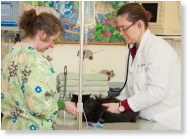Bi-annual physicals for cats
Cats mature very quickly. A 1-year-old cat is equivalent in age to a 15-year-old human. A 2-year-old cat is equivalent to a 25-year-old human. See stage of life care.
All cats should have a physical twice annually to help spot health conditions early before they become major concerns. Cats with chronic conditions (such as diabetes or heart disease) should be seen more often. (See more under Chronic Condition Care.)
Healthy cats under age 7 should get:
-
Annual blood work
-
Twice annual exam to check for changes

Bi-annual physicals help your veterinarian detect health problems early.
Cats age 7 and older (considered “middle age”) should get:
ANNUAL:
-
Blood work to check:
-
Liver and kidney function
-
Blood sugar levels
-
White and red cell counts
-
-
Urinalysis to evaluate kidney function and urinary tract health
-
Rabies vaccine (See Parasites/vaccines)
-
Thyroid screening
-
Fecal testing for intestinal parasites for indoor cats. (3-4 times annually for outdoor cats) (See Parasites/vaccines)
TWICE ANNUAL:
-
Dental exam
-
Ear screen for ear infections and ear mites
-
Weight / body condition exam
-
Blood pressure screen
-
Mammary gland check for females
-
Evaluation for pain
-
Abdominal palpation
-
Anal glands check
-
Eye exam
-
Genital exam
-
Heart and lungs exam
-
Skin and fur exam
-
Behavior review / life enrichment analysis
What is a Microchip?
Microchip Identification significantly increases the odds that you can find your cat should he or she ever run away or get lost. Only 2-3% of cats separated from their families are ever returned. Ask your veterinarian about this painless procedure in which a microscopic chip is injected under your cat’s skin. A special scanner reads the chip so that your pet can be traced back to you.
All cats should also have at least 2 feline leukemia and 2 FIV tests during their lifetime.
For cats that spend ANY
TIME OUTSIDE also consider:
(Discuss with your veterinarian
to make your decision based on complete information and
thoughtful consideration.)
-
Annual feline leukemia test and annual FIV test
-
Strategic deworming
 Spot problems BETWEEN exams. Watch our video:
Spot problems BETWEEN exams. Watch our video:
 At -home nose to tail exam -- Spotting early
warning signs.
At -home nose to tail exam -- Spotting early
warning signs.
Click on the link above or scan the QR code with your smartphone to watch the video!


